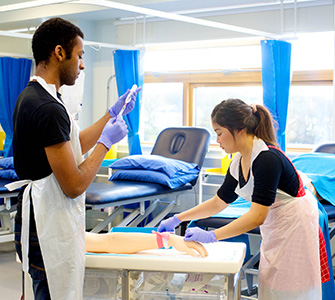If you are considering pursuing a career in medicine, you may be weighing your options for studying MBBS (Bachelor of Medicine and Bachelor of Surgery) in the USA or in India.
Both countries offer excellent medical education programs, but there are some key differences between pursuing MBBS in USA and India. In this blog post, we will explore these differences to help you make an informed decision about where to pursue your medical education.
Duration and Structure of MBBS Program
The path to becoming a doctor in the USA and India differs notably in terms of time and structure. In the USA, the journey starts with a four-year MD program, which you can only begin after completing your undergraduate studies, often taking another four years. This means you could be looking at around eight years of education before earning your MD.
On the other hand, in India, the MBBS program is more straightforward, taking five and a half years right after high school. This period includes both classrooms learning and practical training.
So, while the USA offers an MD with a pre-med requirement, India’s MBBS combines both pre-clinical and clinical education in a single program that starts earlier but also stretches over a significant time.
Admission Process and Requirements
Getting into medical school for MBBS in the USA requires a few steps. First, you must complete an undergraduate degree. Then, you need to take the MCAT, a test that checks your knowledge for medical school. You also have to send in letters that recommend you, a personal essay, and your school grades.
In India, the process is a bit different. You need to pass the NEET exam right after high school to get into MBBS programs. This exam determines if you meet the basic requirements for medical school.
Both countries have their own ways of selecting students for medical programs, focusing on different stages of education.
Practical Exposure and Clinical Training
In the USA, medical students start their hands-on learning in hospitals and clinics in their third year. This practical phase, known as rotations, exposes them to different medical fields, helping them decide on a specialization. They learn by doing, under the supervision of experienced doctors. This approach is aimed at making them confident and competent practitioners.
On the flip side, India integrates practical experience right from the start. MBBS students interact with patients early in their program, blending theoretical learning with real-world application. This continuous exposure to clinical settings from the beginning helps them understand patient care deeply and practically.
Both systems aim to equip future doctors with the necessary skills, though they differ in when and how this hands-on training is delivered.
Cost of Education
When it comes to the price of becoming a doctor, there’s a big difference between the USA and India. Studying MBBS in the USA can put a huge dent in your wallet, with yearly tuition fees ranging from $30,000 to $60,000.
And remember, this doesn’t even cover the cost of living there. In contrast, pursuing an MBBS degree in India is way more budget-friendly. If you opt for a government college, you might only need to spend about $3,000 to $5,000 on tuition fees each year.
This stark difference in education costs plays a significant role for many students when deciding where to study medicine.
Post-Graduation: Residency and Job Opportunities
After earning an MBBS degree in the USA, the next step is entering a residency program, which is necessary for medical licensure. This program can vary in length from three to seven years, depending on the medical specialty chosen. Upon completion, doctors have a wide range of job opportunities across various healthcare settings.
Meanwhile, in India, once students complete their MBBS, they must undertake a mandatory one-year internship. After this, they can either begin practicing medicine or opt for further studies in a specialized field.
Both paths in the USA and India lead to rewarding careers in medicine, though the journey and timeframe to reaching full professional status differ. This phase is crucial for gaining real-world medical experience and solidifying one’s career in the healthcare industry.
Salary of MBBS Doctors in the USA
When it comes to how much MBBS doctors make in the USA, there’s quite a range, and it largely depends on what kind of medicine they practice, where they are located, and how much experience they have. Generally, a doctor just starting out in primary care might see yearly earnings from $150,000 to $250,000.
Specialists, who focus on specific areas of medicine, often earn more, thanks to their advanced training and the complexity of their field. The Salaries Of Mbbs Doctors In Usa are considered to be some of the highest globally.
This difference in income is not just a reflection of the doctors’ skills and dedication but also mirrors the investment in their extensive education and the demand for high-quality healthcare. The potential for a high salary is a significant incentive for many in the medical profession, providing both a rewarding career and financial stability.
Wrapping up
Deciding where to study medicine is a big choice that can shape your future career. The USA and India both provide strong medical education paths, but they differ in critical ways, including the structure and length of the program, the process of getting into medical school, the costs involved, and the opportunities available after graduation.
In the USA, the journey to becoming a doctor is longer and more expensive, but it often leads to higher salaries. In India, the path is more direct and affordable, with a focus on early practical experience. Your decision might hinge on these differences, as well as your own career goals and financial situation. Each path has its unique advantages and challenges.
Therefore, consider what’s most important for your medical career and how you want to achieve it. This will guide you in making a choice that’s best for your ambitions in the healthcare field.

